Thank you for visiting! By the way… any links on this page that lead to products on Amazon and other stores/partners are affiliate links Aquarium Store Depot earns a commission if you make a purchase.
Anubias nana, or to use its more technical name, Anubias barteri var. nana has to be one of the best freshwater plants for beginners. These great-looking plants for freshwater aquariums are really forgiving and can be grown without powerful light or CO2 injection.
If you’re new to the hobby of keeping plants alive in an aquarium, you may be unsure of which plant is best for your first. If so, Anubias Nana might be just the ticket! These hardy little plants are perfect for beginners because they tolerate a wide range of water conditions and grow slowly enough that it’s easy to keep up with their maintenance. This article will teach you everything you need to know about caring for these beautiful aquatic plants.
A Brief Overview Of Anubias nana
| Scientific Name | Anubias barteri var. nana |
| Common Names | Dwarf anubias, nana anubias, petite anubias |
| Family Name | Araceae |
| Origin | Cameroon, equatorial West Africa |
| Skill Level | Easy |
| Lighting | Low to medium light, 40-125 PAR (Umols) |
| Tank Placement | Foreground or Midground |
| Flow Rate | Low, Moderate |
| Temperature Range | 72 – 82 F |
| Height | 6 inches |
| pH Range | 6-7.5 |
| Propagation | Rhizome division |
| Growth Rate | Slow |
| Feed Type | Column or Root Feeder |
| CO2 Requirement | No |
Origins And Habitat of Anubias Nana
This plant was originally collected from around riverbanks near Victoria, Cameroon in West Africa. In nature, it grows wild as a semiaquatic marsh plant. It rarely grows completely submerged in the wild. It is known as an African with the moniker of “the plastic plant that grows” due to it’s dark green leaves that can make it look plastic with its leathery shine.
What Do They Look Like?
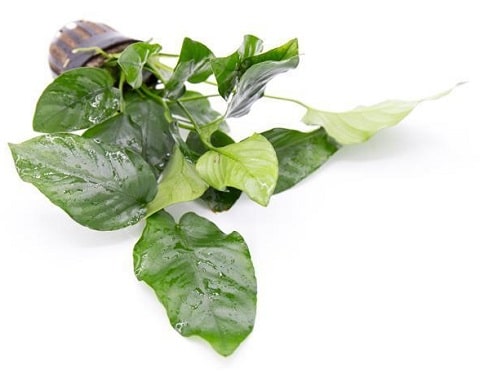
Anubias barteri var. nana is a highly attractive little plant that grows from a thick horizontal rhizome. They are the smallest variety in the Anubias genus that are commonly kept in the aquarium trade.
The plants are firm in texture and the leaves, stems, and rhizome are deep green in color. This is a compact, stocky plant with rounded, horizontally arranged leaves that measure about 1.5-3.5 inches long and about 1.5 inches across. The leaves have secondary veins that are laid out diagonally from the center vein.
Anubias nana is one of the few aquarium plants that can flower fully submerged underwater. The flowers are not particularly impressive but are definitely interesting in the aquascape. You can see an example of the flower from this video by Aquascaping the World By BM.
Placement And Lighting
Anubias nana is a small plant that looks great in the foreground or attached to hardscape features in the midground of the aquascape. They work best in nature-style aquascapes and look especially good when anchored to driftwood in heavily structured, tropical biotopes.
This anubias grows from a thick rhizome that should not be covered by the substrate. The roots growing from the rhizome can, however, be set into the substrate where they will develop and anchor the plant.
With smaller plants, this can be done by carefully pushing the plant’s rhizome into the substrate until the roots are buried and then pulling the rhizome back out slowly and carefully until just the root system are covered and the rhizome is clear.
These dwarf anubias plants can also feed from the water column, and they look great when tied to driftwood or rocks with fishing line, cotton thread, or even glued with a product like Seachem Flourish glue.
Some growers even leave these plants to float, although they are not ideal for this. At least in my experience, when not anchored they tend to drift around until becoming trapped against another plant, often upside-down.
Anubias Nana is a slow grower in a planted tank, with relatively large leaves, and low to medium light requirements. When grown under strong lighting, they tend to develop problems with algae growth on the leaves.
What Are Good Tank Mates?
These plants work great with all sorts of freshwater aquarium fish. Because of their tough leaves, they are one of the few species for the planted tank that most herbivorous fish won’t feed on.
Good Tank Mates
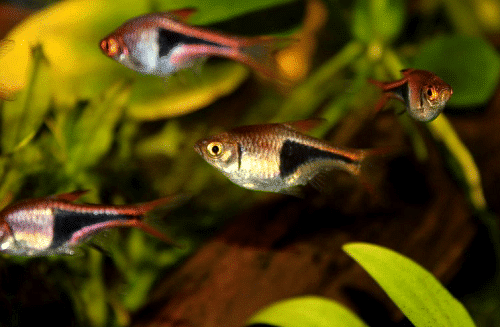
Algae eaters like otos (Otocinclus spp.), siamese algae eaters, and neon blue gobies (Stiphodon spp.) are excellent fish to keep with this plant. These little freshwater fish will actively feed directly from the leaves of the plant. They also do well with any schooling fish like tetras, cherry barbs, and Harlequin Rasboras.
This is one of the few plants that can be safely grown with goldfish and African cichlids. Even though these plants tend to prefer lower pH, they will generally do fine in the alkaline water in African cichlid tanks.
Tank Mates To Avoid
Even though this is one of the best plants for destructive freshwater aquarium fish species, you will still be taking a risk by growing this Anubias with fish like silver dollars and oscars. In an oscar tank, you might have better results by growing this plant attached to the hardscape rather than near the soil.
Feeding And Fertilization
Being a slow-growing plant that will grow in a low tech/low energy tank, fertilizing with aquarium fertilizers isn’t usually necessary or recommended. If you are keeping fish with your plants, the nutrients in their food and waste are likely to be more than enough for these tough little plants.
How Much And How Often To Feed
Fertilizing these plants is not necessary and might do more harm than good. The only time feeding might be a good idea is if you keep these plants in a heavily planted tank with other fast-growing column feeders like stem plants and floating plants that will use up the nutrients and out-compete any algae growth in the system. In situations like this, rooted anubias plants might well benefit from a substrate fertilizer. It would also benefit the plants in general to use an active substrate as this releases nutrients for the plants and will soak in nutrients as bacterial colonies establish themselves.
Different Types
The plant commonly called Anubias nana is actually a variety of the species Anubias barteri. These plants are, therefore, most correctly calledby the name Anubias barteri var. nana.
There are a few other varieties of this species, all of which grow to a larger size and height than nana. Without going into too much detail, Author Christel Kasselmann, in his book, Aquarium Plants describes the following other closely related anubias barteri species:
- Anubias barteri var. barteri ‘coffeefolia’
- Anubias barteri var. angustifolia
- Anubias barteri var. caladiifolia
- Anubias barteri var. glabra
- Anubias Nana Petite
One very popular form of Anubias barteri species in the planted tank hobby is Anubias barteri var. nana ‘petite’. These plants are most often called Anubias nana petite, or sometimes Anubias nana bonsai, and are great little low-maintenance plants. The care of this petite anubias is the same as that of regular Anubias nana except theyare a smaller plant, maxing out at a size of about 2 inches tall.
Care
Anubias barteri var. nana is one of the easiest aquarium plants to care for because of its slow growth rate and low nutrient, low to medium light requirement, and carbon dioxide requirements. In time, you might want to give these plants a trim or remove leaves that have become covered in algae growth but they are generally very low-maintenance. Anubias nana can live for many years, and will usually survive all the mistakes of people that are new to the hobby.

Planted Tank Parameters
Anubias nana and nana petite are hardy in quite a wide range of water parameters. A stable temperature of anything between 72 and 82°F is preferred and pH values of 6.0 – 7.5 are ideal. These plants do, however, tend to do better in mildly acidic conditions. Water hardness does not seem to have much of an effect on these adaptable plants.
Water Quality
Being a robust variety, Anubias nana is more tolerant of changes in water quality than many other freshwater plants. That being said, the aquarist should always strive to keep the conditions in their tank as stable as possible. Maintaining a stable water temperature is also important, so be sure to use an aquarium heater and monitor its performance with a thermometer or aquarium controller.
Filtration
Filtration is extremely important in the planted tank. These plants don’t have any specific filtration needs, but without a good filter, your chances of developing problems with algae are much higher.
So be sure to run a good quality filter in your tank and if you keep fish or other animals, be sure to stock appropriately. The general advice when selecting a filter is to choose a model with a flow rate that is 4-6 times the volume of your aquarium. In a causally planted tank, a hang-on filter will suffice.
However, in a mass planted tank, one needs to factor in the waste many aquatic plants produce. This added bioload demands for a higher end filtration unit. I highly recommended canister filters for mass planted and high end aquascaped tanks.
Flow
Anubias nana and Anubias nana petite are robust and compact little plants that will do well in a wide range of flow strengths. They can be difficult to keep anchored when growing rooted, and a strong flow will probably frustrate you by uprooting your plants. In tanks with faster currents, use a hardscape feature like a rock to protect the plant from any strong and direct flow. The use of a lily pipe will also allow you to use a higher flow filter while spreading the flow throughout the tank.
A lily pipe is a great way to utiliize high flow canister filters in your aquascape while distributing the flow evenly throughout
Aquarium Maintenance
While easy to care for, this plant still requires a good home that is well maintenance. Let’s talk about needs.
Testing Water Conditions
Before buying any new plant, start by testing your water conditions to see if your setup is suitable for that species. You can do this at home quite easily using liquid water test kits.
Water quality can change or fluctuate, especially in tanks with high fish stocking rates. These changes happen especially quickly in small aquariums so be sure to test regularly.
A good time to perform these tests is once every one to two weeks when you’re doing your regular partial water changes. The results will indicate whether your water changes are being done often enough. You will want to test for:
- Ammonia
- Nitrite
- Nitrate
- pH
- Water Hardness
If any of these are off, consider remedying the situation before you plant other aquarium plants.
How To Set Up Your Aquarium Tank
This aquarium plant doesn’t have any really specific tank requirements. They stay small and compact so they are a great choice for smaller tanks, anywhere from about 5 gallons and up. Anubias nana petite could even be grown in smaller aquariums, provided you keep a close eye on your water quality.
A great way to grow this species is by attaching its rhizome to driftwood, rocks, or even an aquarium decoration, so look out for a nice fish-safe piece to use for this purpose.
This variety also grows well when rooted, as long as you keep the rhizome uncovered. The root system will hold well in a fine medium like sand, although a nutrient-rich medium like an aquarium soil will help these plants grow stronger.
How To Propagate
Although they are very slow-growing plants, Anubias nana propagation is easy, even for aquarists with low experience levels. To create new plants, one simply has to divide a mature rhizome. The rhizome is easy to spot, it’s the stem-like structure that the roots grow from.
This structure grows parallel to the ground and, if grown in the right conditions, will grow in length, developing new stems in time. By taking a section of the rhizome with its own leaves and stems, you can easily grow a new plant.
A great video by The Small Scape has one of the best in-depth videos on how to perform rhizome division on these little guys. Check it out below and give her a sub if you like it!
Health And Disease
Signs Of Health
Healthy Anubias nana and nana petite plants will produce new leaves regularly. This is a slow process, but young new growth will have a bright green color, unlike the dark green of mature foliage. Plants with a few small, light-colored leaves are in good health.
Signs Of Ill Health
Avoid plants that are covered in algae, have a damaged rhizome without roots or have full-grown but discolored leaves.
Common Health Issues And Treatment
The most common health issue in Anubias nana and Anubias nana petite is algae infestation. The most common cause of this condition is excessively strong lighting and too many nutrients in the water.
This problem mostly affects plants that have been recently added to the aquarium and have not established strong and healthy root systems and adapted to your water parameters. The best thing to do in this case is to shade these plants by growing them under a floating species or consider adjusting your light strength.
Anubias nana plants that have their rhizome planted below the surface of the soil tend to melt and slowly die. Reposition these plants so that the rhizome is clear of the soil to solve this problem.
Some growers may be concerned about the slow growth of these plants, but rest assured, this is completely normal and healthy for the species.
Plant Pests
The easiest way to start out with pest-free plants, and avoid introducing unwanted hitch-hikers to your tank is to grow tissue culture plants that are propagated under strict lab conditions.
When growing regular potted Anubias nana plants, be sure to inspect them for snails or any other organisms and remove anything you find. Go ahead and remove any dead or diseased plant parts while you’re at it and then wash the plants off carefully before adding them to your aquascape.
You can go one step further and give your plants a bleach dip to kill off anything you might have missed. Use a very weak solution of 20 parts water to 1 part bleach and dip the plant in the mixture for a minute or two. After dipping your plant, be sure to wash it off very carefully to avoid adding bleach to your aquarium.
Where To Buy
Anubius nana and Anubias nana petite are very popular and common aquarium plants. They are easy to find in pet stores, local pet stores, or they can be bought online.
If purchasing online, I would highly recommend purchasing your plants from BucePlant. They offer the highly quality aquatic plants you can find online and offer an amazing selection of both potted and tissue culture plants. Local fish stores that specialize in aquascaping are difficult to find. Give BucePlant a chance if you have no store local to you!
Hardy, forgiving and easy to grow. The Anubias Nana is your ticket to the incredible hobby that is aquascaping!
FAQS
Does they need soil?
Anubias nana plants do not need soil. These plants can be grown quite easily without soil by attaching them to a hardscape feature like driftwood, rocks, or even an ornament.
Can you plant them petite?
Just like its larger form, Anubias nana petite can be planted, as long as its rhizome is kept clear of the substrate.
Does they need CO2?
Of course, all plants need CO2 injection for rapid and healthy growth. When it comes to Anubias nana petite, however, the background carbon dioxide levels in most home aquariums is enough for healthy growth.
Injecting CO2 could well result in faster, healthier growth. The challenge is to match the lighting and feeding in a way that will not result in unwanted algae growth.
Do they need fertilizer?
These plants generally don’t need any fertilizer. If you keep fish in your tank, the nutrients in their waste and feed should be more than enough for this species.
Can you plant them in substrate?
This species can be planted in the soil and will grow very well if set up this way. The key to success with this method is to make sure that rhizomes are not covered by the soil.
Roots from the rhizome will grow into the soil in time, and it is best to anchor the plant with a few stones or something similar until it is secure.
What Questions Do You Have?
Anubias Nana is a wonderful plant for beginners because it tolerates a wide range of water conditions and grows slowly so that maintenance is easy. If you’re new to the hobby of keeping plants alive in an aquarium, this article should have helped teach you everything you need to know about caring for these beautiful aquatic plants. Leave us your thoughts on whether or not this was helpful by leaving a comment below! We’d love to hear from you!
- About the Author
- Latest Posts
I’m thrilled that you found Aquarium Store Depot! Here you’ll find information on fish, aquariums, and all things aquatics related. I’m a hobbyist (being doing this since I was 11) and here to help other hobbyists thrive with their aquariums! I adhere to a high quality Editorial Process and Review products with real life field usage and practical analysis.

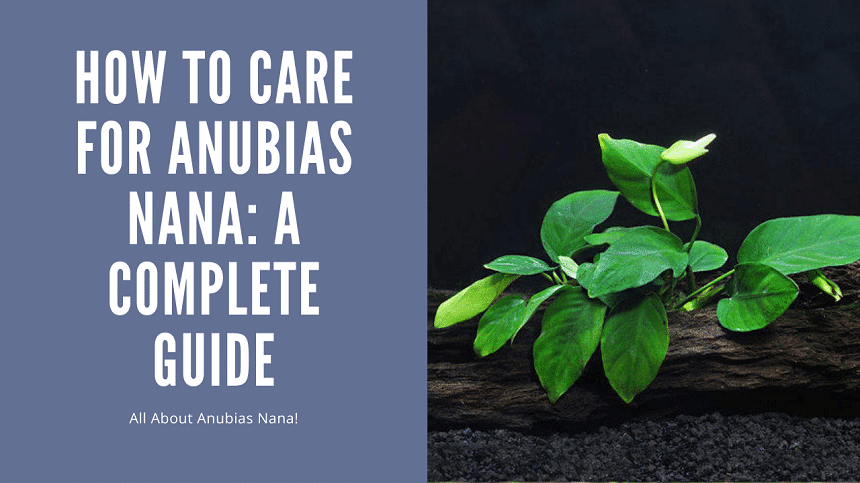
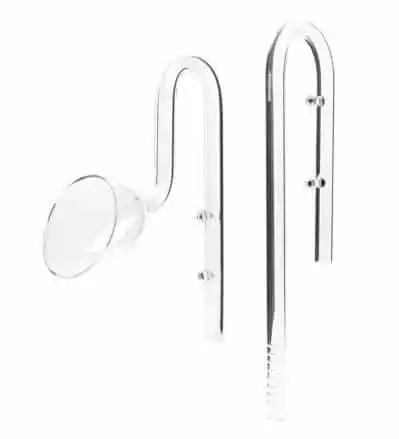
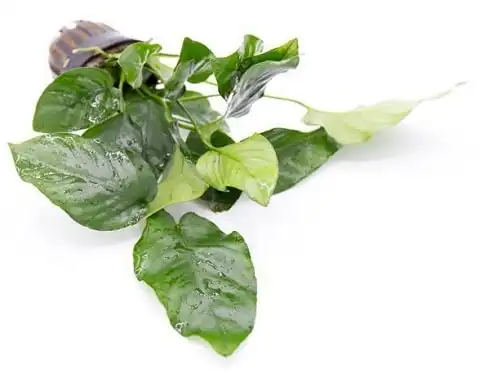




I very new to this plant and the more I read about the care of the Anubias Nana the more confused. My first question concerning the water. My only source of the water is my kitchen faucet. What do I need to do to prepare this water to make a livable environment for the plant? I do not want an aquarium with fish. What I am considering is a medium fish bowl. What I am confused about is the size of the container. I only have a single small plant. Does the “fish bowl” qualify as an aquarium? I ask because everything I’ve read so far refers to an aquarium. Without the fish waist will I need fertilizer? How often will the water need to be changed or added to? I really appreciate any information you can provide. Thank you.
Hi there. You can keep a fish bowl without fish and only plants. Anubias Nana is just the wrong plant to use. Try Java fern or water sprite instead